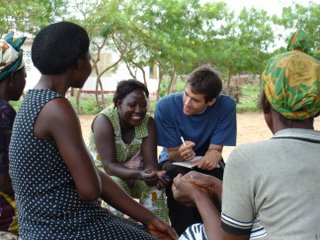
Mormons sometimes refer to Jesus as their "Elder Brother." This phrase is troubling to many onlookers from traditional Christianity as they see it as lowering the status of Jesus from God and King or putting us as practitioners on the same level as Jesus. It is a phrase that fuels their claims that we worship 'another Jesus' or the
ridiculous smear tactic of saying Jesus and Satan are brothers, which was even
used by Mike Huckabee in the presidential race, putting the issue in national papers.
Now, I understand why Mormons use this phrase and I'll summarize the doctrine later in this post, and I know the intentions of Mormons are not as the onlookers surmise, but in this case I am going to side with our critics and challenge Mormons to examine the words they casually use in their testimonies and prayers to see if this cultural pattern aligns with our doctrine.
This phrase, "Elder Brother" is not found in scriptures, neither Bible nor other
LDS scripture. The principle of it is in the Bible, a combination of Jesus being the "Firstborn" and "Son of God" and all mankind being referred to as the "children of God". The reason the concept has gained prominence in Mormonism is due to unique
LDS doctrines about what took place before the creation of the earth particularly as taught in the book of Abraham and the 93rd section of the D&C. Abraham 3 paints a scene in which God the Father is standing in the midst of spirits and among the crowd is the future Abraham and presumably other prophets as part of the "noble and great ones" and it is open to interpretation how far that net is cast. --In passing I will point out that it implies that there were some 'not-so-noble and not-so-great ones', I might have been in that category :) -- Then the spirit person who would come to earth and whom we know as Jesus is described as being "one among them" but with the adjective of being "like unto God." D&C 93 talks about Jesus receiving "not of the fullness at first" but that he became 'like unto God', "grace by grace". So there are some referrences in
LDS scriptures that put Jesus "among" the wider family of humanity in the
pre-earth realm and suggest development and growing into the role of Savior, but Christ is never lowered from his role or status, the added understanding is that mankind has divine heritage and potential and that only testifies to the power of Christ in His role.
I suspected the phrase may have had origins in the
LDS hymnal but that search revealed that although there are some hymns that emphasize
Jesus' role as friend and
comforter, the phrase "Elder Brother" is never used and the vast majority of
LDS hymns actually have the opposite emphasis, i.e. praising of Christ in his role as God, Savior, and King. My limited search on lds.org, along with the help of
some friends, shows that the phrase first surfaces with Brigham Young and then can be found in
discourses by most of the
LDS prophets since then but always in passing, usually in reference to Christ's leadership role in the
pre-earth realm.
I think the phrase is most common at the local level of discourse and vernacular in the Church, and just gradually became a common phrase members use in prayers and testimonies. I don't think it is used all that much, it is definitely used more by critics of the church than it is
actually used by members. I listened for it in the last fast & testimony meeting in my ward and never heard it.
Again, I understand the doctrine and believe the phrase is accurate, I understand Mormons' excitement for this additional understanding of Jesus in the
pre-mortal realm, and I believe that Mormons use it with
reverent intimacy, but...
If we look at all the titles used to describe Jesus and their relative frequency in scripture, including how prophets refer to Him, how He refers to Himself and how God the Father addresses Him, we should be using this phrase "Elder Brother" rarely or not at all in following that established pattern. Additionally, I think there is always a tendency to become too casual in our reference to
Deity and this phrase lends itself moreso to casualness. I think there are other ways of expressing the beautiful doctrine of Christ's role as the Firstborn and preordained Savior of mankind as well as the intimate friendship he provides.
Changing our language would put us in greater alignment with the language of our scriptures and save us a lot of misunderstanding when communicating with the greater Christian community.








